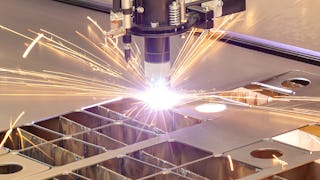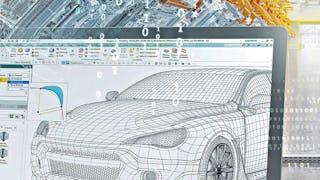Variability is a fact of life in manufacturing environments, impacting product quality and yield. Through this course, students will learn why performing advanced analysis of manufacturing processes is integral for diagnosing and correcting operational flaws in order to improve yields and reduce costs.


Get a Black Friday boost with $160 off 10,000+ programs.Save now.


Advanced Manufacturing Process Analysis
This course is part of Digital Manufacturing & Design Technology Specialization

Instructor: Rahul Rai
26,774 already enrolled
Included with 
(1,208 reviews)
Skills you'll gain
Details to know

Add to your LinkedIn profile
13 assignments
See how employees at top companies are mastering in-demand skills

Build your subject-matter expertise
- Learn new concepts from industry experts
- Gain a foundational understanding of a subject or tool
- Develop job-relevant skills with hands-on projects
- Earn a shareable career certificate

There are 3 modules in this course
The purpose of this module is to introduce the concept of advanced analysis in improvement of manufacturing processes. Also, this module will help you to understand the difference between discrete manufacturing and continuous manufacturing.
What's included
5 videos3 readings3 assignments
Storing big data is quite different from handling traditional data. This difference is explained in this module. The purpose of this module is to introduce various steps involved in data analysis. Data Collection, Data Storage, Data Organization and Data Pre-processing concepts are explained.
What's included
4 videos4 readings5 assignments1 discussion prompt
The purpose of this module is to introduce various techniques used in advanced analysis, like Determination of Significant Variables/Factors, Data Visualization, and Anomaly Detection. Also, this module will introduce various computational platforms (HPC, Cloud computing techniques) that exist for carrying out advanced analysis.
What's included
5 videos7 readings5 assignments1 discussion prompt
Earn a career certificate
Add this credential to your LinkedIn profile, resume, or CV. Share it on social media and in your performance review.
Instructor

Explore more from Mechanical Engineering
 Status: Free Trial
Status: Free TrialUniversity at Buffalo
 Status: Preview
Status: Preview Status: Free Trial
Status: Free TrialUniversity at Buffalo
 Status: Free Trial
Status: Free TrialUniversity at Buffalo
Why people choose Coursera for their career




Learner reviews
1,208 reviews
- 5 stars
69.28%
- 4 stars
23.17%
- 3 stars
4.80%
- 2 stars
1.57%
- 1 star
1.15%
Showing 3 of 1208
Reviewed on Jun 29, 2020
The videos are very satisfying and seems to be the kind of work I like to do. But I think the teacher should make everyone let know that computer or laptop is a necessity for the course.
Reviewed on Jul 28, 2020
This course is very useful for every engineer.This course is mostly for mechanical engineers those who are going to have real time experience in their future
Reviewed on May 22, 2020
This course provides amazing content on the manufacturing process analysis and includes many real-world examples. The concepts are very well delivered by the instructor.

Open new doors with Coursera Plus
Unlimited access to 10,000+ world-class courses, hands-on projects, and job-ready certificate programs - all included in your subscription
Advance your career with an online degree
Earn a degree from world-class universities - 100% online
Join over 3,400 global companies that choose Coursera for Business
Upskill your employees to excel in the digital economy
Frequently asked questions
To access the course materials, assignments and to earn a Certificate, you will need to purchase the Certificate experience when you enroll in a course. You can try a Free Trial instead, or apply for Financial Aid. The course may offer 'Full Course, No Certificate' instead. This option lets you see all course materials, submit required assessments, and get a final grade. This also means that you will not be able to purchase a Certificate experience.
When you enroll in the course, you get access to all of the courses in the Specialization, and you earn a certificate when you complete the work. Your electronic Certificate will be added to your Accomplishments page - from there, you can print your Certificate or add it to your LinkedIn profile.
Yes. In select learning programs, you can apply for financial aid or a scholarship if you can’t afford the enrollment fee. If fin aid or scholarship is available for your learning program selection, you’ll find a link to apply on the description page.
More questions
Financial aid available,



